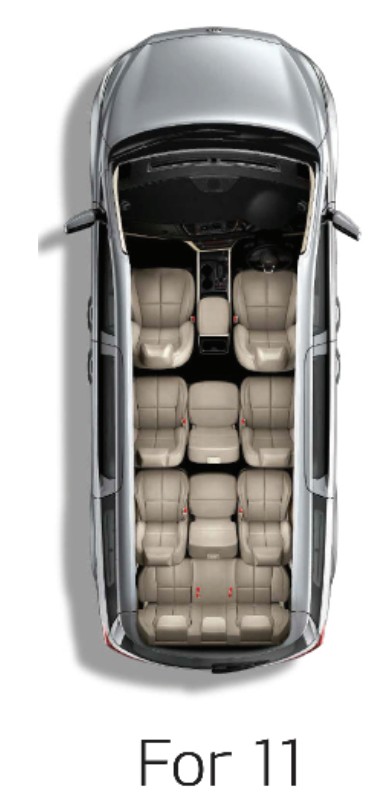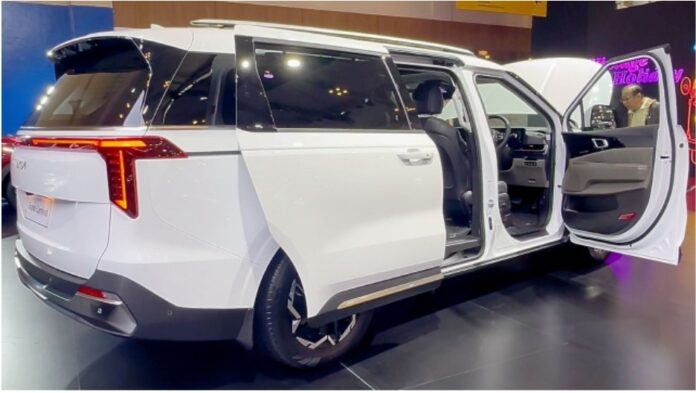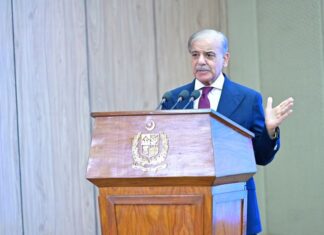KIA Lucky Motors is set to launch a new face-lift version of their multi-purpose (MPV) vehicle, Carnival. What remains to be seen is how KIA Lucky Motors will price the new model.
While bookings have opened at dealerships, there remains some uncertainty over what the final price of the vehicle will be. The car’s previous model, the Carnival Executive, was priced at Rs 1.61 crores (ex-showroom). Dealerships are split over what the price increase will be, with some expecting an increase of Rs 4-6 lakh, while others believe the increase could be as high as Rs10 to 15 lakhs.
As with all cars in Pakistan, the main determining factor for the Carnival remains how expensive imports are depending on the rupee-dollar parity. Now, the rupee has been pretty stable for the past year or so. One factor that makes the Carnival’s pricing unique are customs duties. You see, the Carnival is an 11-seater car. The only other cars with that kind of seating capacity are commercial vehicles, for which customs duties are different.
The customs angle
Let us explain. The crux of the matter relates to how Pakistan’s customs are levied on CBUs. With the Carnival, KIA managed to play four-dimensional space chess whilst the rest of the industry was busy playing checkers. You see most cars in Pakistan are imported in parts and assembled here. Cars that are imported already assembled, or ‘CBU’ completely-built-units, are more expensive because of which the government piles on customs costs.
Pakistan Customs employs a two-round structure to levy duties as they are dependent upon whether an automobile has a combustion engine, is a hybrid electric vehicle (HEV), or an electric vehicle (EV). When thinking of these categories, most people do not realise one of the categories within the combustible engines section are commercial vehicles.
Now this may sound odd at first glance as to why we are equating the sleek KIA Carnival with something that we may associate normally with, say e.g. a Suzuki Bolan known as carry dabbas in our vernacular. The interesting part about this is that the KIA Carnival, or at least the one available in Pakistan, has a higher seating capacity than the Bolan and this is where Lucky Motors have worked their magic. There are two categories of commercial vehicles per Pakistan’s Customs Code; motor vehicles for the transport of goods and motor vehicles for the transport of ten or more passengers, including the driver.
The Carnival has 11 seats.
It is this particular nuance that allows the KIA Carnival to be subject to the lowest total tax incidence within the combustible engines section, and overall amongst all CBUs.
Under recent revisions to the withholding tax which have come into effect since 1st July 2024, tax filers will be required to pay a 12% withholding tax on the invoice price, whereas non-filers will incur a hefty 36% withholding tax rate.
This strategic classification has kept previous models of the Carnival relatively affordable despite regulatory challenges. The new facelift model should capitalise on this positioning while contending with increased competition from both high-end SUVs and new EV options.
What to expect from the new Carnival?
The new facelift model comes at a time when KIA, as well as other car assemblers, are trying to figure out how to best appeal to customers whose purchasing power for new cars has drastically fallen.
While KIA experienced a 53% decline in sales in the previous calendar year, this year its Stonic EX+ became overbooked after a price reduction of Rs 15 lakhs. This reiterates the need for sustainable pricing as affordability has become a key issue for car buyers.
Despite the official price not yet being confirmed, KIA’s authorised dealership at 9th Avenue, Islamabad, reported that three orders have already been placed, each with a Rs 40 lakh booking deposit. However, the final price still remains unknown.
Interestingly, while some dealerships have opened bookings, others, like the Clifton dealership in Karachi and even KIA’s head office, have expressed limited awareness about the new model’s arrival and pricing, causing some confusion among customers.
Since entering Pakistan in 2018, KIA, under its partnership with Lucky Motor Corporation, has positioned the Carnival, which was its first passenger vehicle in Pakistan, as a bold contender in a variety of categories. Its 11-seat configuration has allowed it to be classified as a commercial vehicle, sidestepping higher duties typically applied to CBUs.
One interesting development that could have been was the introduction of a hybrid variety of the Carnival. Pakistan allows 50% exemption in duties and taxes for imported Hybrid Electric Vehicles (HEV) with an engine capacity of 1.8L, and a 25% reduction for larger engines up to 2.5L. However, there is no room for Carnival 3.5L engines within these exemptions.
The target market
The proposition of the Carnival remains the same. In its design and marketing, it is a luxury vehicle. However, its size and seating capacity means it can be categorised as a commercial vehicle. The question is, who will buy an 11 seater SUV that is priced and has components of a luxury vehicle? Even though the Carnival offers more seating capacity, it has smaller competitors in the same price range, which means only someone that needs the seating capacity would want to buy the car.
The facelift is also being introduced at a time when petrol prices also remain high, which adds to the financial considerations for potential buyers of this 3.5 litre petrol-engine MPV.
Profit previously reported Toyota Hiace, maybe more of a minivan, as the closest competitor to this MPV though at a distant price and utility. But with this facelift, it’s possible that this comparison becomes unfair.
Why? Because with the new facelift and its premium features, the car becomes a very good prospect for families, particularly from the perspective of long-distance travelling.
The target market consequential to Carnival’s pricing includes larger families, corporate buyers, and even commercial users who need a vehicle that combines seating capacity with comfort, as shown below. But with the facelift looking even more like an SUV, it opens up a market opportunity to target an even greater number of car buyers.
Unlike other recent entries in the market, such as the BYD EV and KIA’s own EV5, the Carnival continues to cater to a niche segment with its spacious seating and high-end features like a seven airbags, dual sunroof, advanced driver-assistance systems, and high-tech infotainment options.
Sara Tariq, Head of Sales at Kia Motors 9th Avenue, emphasised that it is “the one and only 11-seater luxury car,” designed for consumers seeking spacious luxury without the compromises of an SUV or minivan.

While specific details about new features are yet to be officially released, the facelift which has already been launched globally has recorded 5645 sales in its home market of South Korea, while in India 1822 bookings were recorded in the first 24 hours after its launch on 16th September.
What remains constant is Carnival’s ability to merit the lowest classification of these duties by having more than ‘10 seats’, and therefore operating as a commercial vehicle for tax purposes.
As Pakistan’s automotive landscape shifts and the middle class diminishes, the Carnival facelift provides limited opportunity to capture a much-smaller market. And with rising prices and economic uncertainties, the real question remains: will the Carnival facelift retain its appeal amid increasing financial pressure on consumers and uncertainty surrounding its final price?
























